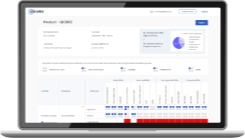
Consider the story of IBM during the 1990s. Under Lou Gerstner, IBM shifted from being a hardware-centric company to a global services powerhouse. Gerstner didn’t come in to focus on the technology; he focused on aligning IBM’s people with a common purpose. Compare this to Kodak, which failed to embrace a similar people-first transformation. Despite having the technology to lead the digital revolution, Kodak’s leadership didn’t empower its people to adapt and innovate, resulting in its downfall. So what do we take away from this story? A people-first mindset can drive transformation even in a time of change.
"You don’t build a business. You build people, and then people build the business." - Zig Ziglar, Motivational Speaker
As organizations navigate the complexities of digital transformation and AI integration, the true challenge lies not in the technology itself, but in how organizations empower their people to lead and innovate. It’s essential to focus on cultivating a culture where employees are equipped with purpose and autonomy, ensuring they drive the transformation, not just adapt to it.
This blog takes a closer look at what it means to truly lead a People-First Transformation, where your workforce doesn’t just adapt to change but drives it, becoming your most valuable asset in a rapidly evolving world.
What is People-First Transformation?
People-First Transformation is an organizational approach that places employees at the core of its strategy, recognizing that true transformation happens when people are empowered and aligned with the organization's mission. It involves cultivating a culture where purpose, autonomy, and growth are prioritized. Through inclusive leadership, continuous skills development, and well-being initiatives, organizations create environments that foster engagement, loyalty, and innovation.
“Flexible work options, career development, and inclusivity create a supportive work environment that satisfies employees' intrinsic needs for autonomy, growth, and belonging.” - People First: Transforming HR Practices to Enhance Employee Engagement and Retention
By aligning technology with human potential, People-First Transformation ensures that employees lead the change rather than simply adapting to it, ultimately driving sustainable growth and resilience in a rapidly evolving world.
Why People-First Matters More Than Ever in a Tech-Driven World
As organizations race to adopt automation, embrace AI, and scale digital transformation, the spotlight naturally shifts toward efficiency, speed, and performance. These are critical goals. But when pursued in isolation, they create a dangerous imbalance because what often gets left behind is what holds transformation together: people.
In the rush to optimize systems, cultural health begins to slip. Performance metrics may improve on paper, but engagement, clarity, and emotional connection decline. And when systems move faster than the people inside them, transformation doesn't just slow down, it fractures. Not because the technology failed, but because people weren't equipped or empowered to move with it.
So the real question is, what happens when people lead the transformation?
The data tells a compelling story.
According to McKinsey, organizations that actively involve employees, giving them ownership in digitization and process improvement, are 1.4 times more likely to achieve successful transformation outcomes. In other words, when people aren't just asked to adopt change but are trusted to help shape it, performance rises.
Gallup reinforces this insight across multiple fronts. Their global workplace research shows that engaged and emotionally connected employees lead to a 78% drop in absenteeism and a 70% improvement in well-being. These aren't soft metrics; they are the foundation of sustained productivity and retention.
And in moments of crisis, the difference becomes even more visible. Gallup also found that organizations that invest in employee experience outperform their peers during economic downturns, proving that people-centric cultures are more resilient under pressure.
This isn't just about morale. It's about momentum. It's about building organizations that last.
"When leaders establish a culture centered on employee engagement and adopt science-based management practices, the result is increased productivity, innovation, and profitability. Engaged employees are psychological 'owners'; they drive performance and move the organization forward." - Gallup, Global Workforce Report 2025
This is the real competitive edge in a world of rapid change.
- Engaged employees don't just follow instructions; they improve them
- Psychologically safe teams don't hide mistakes; they fix them
- Cultures built around trust and belonging don't collapse in disruption; they adapt through it
The Core Principles of People-First Transformation
A people-first transformation isn't a slogan or a one-time initiative; it's a reorientation of how business is led, decisions are made, and value is created. It's a mindset shift, a systems redesign, and most importantly, a commitment to putting human experience at the center of performance.
Here are five core principles that define what makes this kind of transformation real and sustainable:
.webp)
1. Purpose-Led Alignment
People-first transformation begins with clarity of purpose shared, not imposed. In today's workplace, purpose isn't a soft value; it's a strategic lever for performance.
According to McKinsey's research, 70% of employees say their sense of purpose is defined by their work. Yet, only 18% believe they get as much purpose from work as they want. This gap signals both a risk and an opportunity.
Purpose gives people a reason to care and contribute beyond tasks. Whether you're reshaping a tech empire or reimagining daily routines, aligning work with meaning drives intrinsic motivation, resilience, and initiative.
Leaders must ensure that every individual, across every level, sees themselves in the mission and feels empowered to make decisions that move it forward. Because when purpose becomes personal, performance becomes exponential.
2. Trust and Autonomy
A People-First Transformation requires shifting from control to confidence, enabling individuals to own their roles, manage their time effectively, and take responsibility for their outcomes. This means letting go of micromanagement, endless approvals, and rigid routines in favor of autonomy, ownership and accountability rooted in mutual respect.
A compelling illustration comes from Google’s famous “20% time” policy, which has deep roots in the company’s culture. Employees are given the autonomy to spend a fifth of their work time on self-directed projects. Google’s model found that this freedom sparked creativity, improved job satisfaction, and led directly to innovative products confirming the link between autonomy and organizational performance.
In the past, many organizations preferred tight oversight and standardized procedures. Today, the trend is shifting toward high-trust, low-control environments because autonomy helps people feel seen, capable, and accountable.
3. Psychological Safety and Inclusion
Purpose gives people a reason to care. Autonomy gives them the power to act. But even the most driven and self-directed employees can start to falter if they feel unsupported.
That’s the paradox of responsibility: when people are trusted to lead, make tough calls, and carry real weight, it can also leave them vulnerable to fear, fatigue, and self-doubt.
In high-performing environments, this often goes unnoticed. People keep pushing, but silently start to withdraw. They hesitate to raise concerns. They second-guess their instincts. They stop asking for help.
That’s where psychological safety becomes essential as a protective mechanism that keeps initiative from turning into isolation.
In a psychologically safe culture, people know they can speak up without punishment. They can admit what they don’t know, share an idea that’s half-formed, question a decision, or acknowledge a mistake because the environment encourages learning over blame.
It’s the difference between surviving pressure and growing through it.
But safety alone isn’t enough. It must be paired with true inclusion.
Inclusion means that people don’t have to shrink parts of themselves to fit in. They don’t have to mask their identity, background, or perspective to be taken seriously. It means that everyone, across all levels, genders, ethnicities, neurotypes, and roles, feels that they belong, that they’re visible, and that their input matters.
This isn’t about checking a box. It’s about unlocking contribution. Because when people feel safe and included, they don’t hold back. They lean in, speak up, and stay resilient even when the work is hard.
4. Growth Mindset at Every Level
Stagnant cultures protect the status quo. People-first cultures challenge it. This mindset, famously championed by Satya Nadella, rewards curiosity over certainty, learning over perfection, and collaboration over individual heroics.
When employees are encouraged to be "learn-it-alls" instead of "know-it-alls," they begin to take risks, experiment, and grow, and that energy fuels enterprise-wide momentum.
This shows how AI tools, while enhancing speed and efficiency, can also be leveraged to support a growth mindset by sparking creativity and enabling new ways of thinking.
5. Human-Centered Systems and Execution
People-first transformation can’t survive on philosophy alone; it needs infrastructure. The systems, processes, and tools that shape everyday work must reflect the values leaders say they believe in.
That means designing operations that serve people, not just productivity metrics.
Performance reviews must evolve from evaluation to development. Feedback loops must be built for dialogue, not surveillance. Digital tools must be intuitive, inclusive, and built to enable, not overwhelm, employees. And decision-making frameworks must weigh not just efficiency, but empathy, equity, and impact.
Because when systems only chase performance, people burn out. But when systems are designed with people in mind, performance becomes sustainable.
This requires stewardship, not just strategy. A dedicated team or leader must constantly ask: Is this working for our people, not just our KPIs?
That’s how people-first transformation moves from a campaign to a culture.
Real-World Wins: Microsoft’s Transformation Under Satya Nadella
In 2011, a biting cartoon made the rounds online. It showed Microsoft’s organizational chart as a set of color-coded silos, each shaped like a pyramid, each with leaders at the top, and each pointing guns at one another. Drawn by a Google employee, the illustration didn’t just go viral; it hit a nerve inside Microsoft itself.
Satya Nadella, a 24-year Microsoft veteran at the time, was one of the many who saw it. But unlike others, he couldn’t let it go. When he became Microsoft’s third CEO in 2014, he didn’t brush it off as satire. He took it as a mandate: “Renewing our company’s culture would be my highest priority,” he declared.
The Culture of War
Under previous leadership, Microsoft had become a battlefield. Bill Gates’ notorious temper, Steve Ballmer’s territorial team structures, and a fixed mindset culture had turned the company inward. Teams competed rather than collaborated. Innovation was strangled by bureaucracy. Employees were rewarded for being the smartest in the room, not the most curious or collaborative.
The company was struggling. Its $7.6 billion acquisition of Nokia had tanked. Windows sales were in decline. The Xbox One launch had been mocked. Despite its legacy, Microsoft had lost its footing.
The Shift in Mindset
Nadella’s first email to employees as CEO set the tone. “Our industry does not respect tradition, it only respects innovation,” he wrote. “Every one of us needs to do our best work and help drive cultural change.”
But this wasn’t just about pep talks. Nadella grounded his philosophy in psychology, specifically, Stanford professor Carol Dweck’s concept of growth mindset: the belief that abilities can be developed through effort and learning, rather than being fixed traits.
He encouraged employees to stop being “know-it-alls” and become “learn-it-alls.” Microsoft stopped rewarding individual heroics and started evaluating employees on three dimensions:
- Their personal impact
- How they contributed to others’ success
- How they built on others’ work
This shift wasn’t just internal. It extended to everything from rethinking Microsoft’s rivalries to designing more inclusive products.
From Stack-Ranking to Stretching Potential
Microsoft scrapped its infamous stack-ranking system, which had turned coworkers into competitors. Instead, performance reviews became conversations. Managers were trained to model, care, coach, and mentor with empathy and investing in growth, not just results.
Posters reminding employees to use a growth mindset popped up across campuses (sometimes met with eye-rolls, yes, but they were working). Meeting rituals changed. Even day-to-day feedback was infused with the language of learning.
Meanwhile, Nadella began pushing top executives into stretch assignments, unfamiliar and uncomfortable roles designed to force learning.
One standout: Peter Lee, a research VP, was sent to build Microsoft’s new healthcare business from scratch. “It felt like a jump into the abyss,” Lee said. But it worked. He grew, and so did the business.
Letting Go of Old Enemies
Under Ballmer, Microsoft clung to internal turf wars and external grudges. Windows was king. Linux was the enemy. Microsoft even killed innovative projects if they didn’t fit the existing mold.
Nadella dismantled this mindset.
Microsoft now works with Linux, supports rival platforms on Azure, and has made strategic deals with former adversaries like Salesforce. “Microsoft loves Linux” became not just a tagline, but a symbol of a company letting go of pride for the sake of progress.
Imperfect, But Human
Not every step was graceful. Nadella himself stumbled early on when he publicly suggested that women should rely on “faith” and “karma” instead of asking for raises. The backlash was swift.
But his response was textbook growth mindset: he owned it, apologized, and reflected on his own blind spots.
Later, he wrote: “It helped me confront an unconscious bias I didn’t know I had... and find a new sense of empathy.”
The company still grapples with inclusion, especially in leadership diversity. A pending gender discrimination lawsuit, activism around partnerships with ICE and the oil industry, and employee protests have all forced introspection. But here, too, the company is learning in public, releasing diversity data, redesigning evaluation systems, and building inclusive products like the Xbox Adaptive Controller.
The Result? A $1.6 Trillion Reinvention
When Nadella took over, Microsoft’s market cap was around $300 billion. Today, it’s north of $1.6 trillion. But the transformation wasn’t just financial, it was cultural.
Where once there was rivalry, there’s now collaboration. Where there was fear of failure, there’s now psychological safety. The cartoon of warring gangs no longer defines Microsoft. Instead, it’s become a case study taught in business schools and HR conferences alike.
Because Satya Nadella didn’t just hit refresh on Microsoft’s strategy, he hit refresh on its soul.
How to Implement People-First Transformation - Roadmap
Imagine walking into a workplace where people show up with purpose, where team members are genuinely invested in what they do. This isn’t a perk-fueled fantasy. It’s what a people-first transformation looks like when done right.
.webp)
But getting there doesn’t happen by accident. It starts with a mindset shift and is built step by step through purpose, trust, intentional support, and the right execution strategy. Let’s walk through how to make it real.
Step 1: Begin With Purpose and Autonomy
Clarifying purpose is about making the organization’s “why” visible and actionable in the everyday decisions people make. To do that:
- Leaders must translate strategy into meaning for each function, not just where the company is going, but why it matters to the team executing it.
- Managers must localize purpose, helping each employee connect their role to the bigger picture. This might require 1:1s focused less on performance, more on impact.
But clarity without autonomy leads to micromanagement. That’s why the second lever of empowered execution is just as critical.
To build autonomy into the operating model, organizations must:
Redesign roles for ownership, not oversight
- Move from task checklists to goal-based charters
- Let employees co-create KPIs and define how they’ll achieve them
Rework communication rituals
- Replace status meetings with asynchronous updates
- Use team huddles for decision-making, not just reporting
Reframe management behavior
- Train managers to coach, not command
- Shift from “Are you on track?” to “What’s blocking you?”
These shifts aren’t always smooth. When autonomy is introduced suddenly, some employees may feel overwhelmed, unsure of expectations, lacking direction, and hesitant to make decisions on their own.
At the same time, many leaders struggle to relinquish control. Letting go of approvals, detailed oversight, or tightly held processes can feel like risking consistency, quality, or speed. This tension often leads to half-steps, where autonomy is granted in name but withheld in practice.
That’s why support structures are critical. Organizations that succeed in making this shift don’t leave autonomy to chance; they design it with intention. They build in guardrails like lightweight check-ins, transparent OKRs (Objectives and Key Results), and outcome-driven retrospectives to keep teams aligned without micromanaging.
Equally important is leadership training. Frontline leaders need tools and training to support autonomy without becoming distant or disengaged. That means learning to coach and mentor instead of command, guiding instead of directing, and listening actively without rushing to fix.
In short, purpose tells people where to go. Autonomy lets them choose how to get there.
Step 2: Rethink What Support Really Looks Like
True support begins with a shift in mindset: from “what benefits do we offer?” to “what do our people need to thrive?” This means digging deeper than surface-level perks and designing a culture that proactively addresses the lived experiences of your workforce burnout, role confusion, mental fatigue, or lack of growth.
Here’s what that process looks like in practice:
- Listen Beyond Surveys: Many organizations rely solely on annual engagement surveys, which capture sentiment in snapshots. People-first organizations go further. They implement continuous listening mechanisms, pulse checks, anonymous feedback platforms, team huddles, and one-on-one conversations, allowing them to respond in real-time to emotional, cognitive, and professional friction.
Challenge: Employees may initially hesitate to open up, especially in cultures where feedback was historically ignored or punished. Leaders must rebuild trust through follow-through.
- Redesign Roles with Clarity: Support also means clarity. When roles are vague or expectations shift frequently without communication, stress compounds. People-first organizations take the time to map responsibilities clearly, align them with team goals, and remove unnecessary friction in decision-making.
Challenge: Managers may resist this clarity, fearing it will reduce flexibility or expose capability gaps. But clarity doesn’t limit it; it liberates.
- Enable the Managers Who Shape Daily Experience: Support systems break down if frontline managers aren’t equipped to deliver them. That’s why successful organizations prioritize manager enablement: not just teaching them what to do, but how to coach, listen, and support without rescuing or micromanaging.
Challenge: Many mid-level managers have been promoted for performance, not people leadership. Upskilling them for empathy, feedback, and boundary-setting takes time and commitment.
- Personalize Wellness and Growth: A one-size-fits-all approach to wellness is no longer sufficient. Employees today expect holistic care: mental health support, flexible schedules, coaching, and meaningful career development. People-first organizations segment support not just by role, but by life stage, location, and need.
Challenge: HR teams may feel overwhelmed by the scale of personalization required. However, using technology to segment support journeys, just as we do for customers, can make this scalable.
- Make Career Growth Tangible: People can’t stay engaged if they can’t see a future. A key pillar of support is creating visibility into how an employee can grow within the company through clear career pathways, access to learning, and internal mobility opportunities.
Challenge: Without an integrated skills and talent system, identifying growth paths becomes anecdotal and biased. That’s why data-driven internal talent marketplaces and skill audits are becoming core to people-first support.
Ultimately, support isn’t soft. It’s a structured, responsive, and evolving capability. When done right, it gives people the resilience to push through challenges and the trust to stay committed even when the work gets hard.
Step 3: Shift from Engagement Scores to Experience Design
Most organizations track how employees feel at work. Far fewer design how it feels to work there.
That’s the gap between engagement and experience.
People-first transformation is about intentionally shaping the everyday moments that define the workplace. It demands a systemic redesign of the employee journey, grounded in empathy and executed with rigor.
Here’s how you can approach it:
Map the Experience Journey, End to End: The first step is visibility. Companies start by mapping the full employee lifecycle from pre-boarding and onboarding to daily routines, performance conversations, learning touchpoints, and even exits.
This involves collecting qualitative data from interviews, focus groups, and shadowing, not just survey scores.
For example:
- What does the first day feel like?
- Are team rituals energizing or draining?
- Do employees feel safe speaking up in meetings?
HR often lacks bandwidth or access to deep behavioral insights. Involving cross-functional teams (e.g., IT, L&D, managers) and leveraging journey mapping software can streamline the process.
Identify “Moments That Matter”: Not all experiences carry equal weight. People-first teams prioritize the moments that disproportionately impact trust, belonging, and motivation.
These may include:
- The onboarding welcome call
- First team feedback session
- How a mistake is handled publicly
- Recognition after a tough sprint
- A leader’s behavior during a crisis
Once identified, these moments are prototyped, scripted, and reinforced through systems, not just good intentions.
Leaders may underestimate the emotional weight of small moments. Training and storytelling help create awareness and buy-in.
Rethink Manager Behaviors and Team Rituals: Managers are the single biggest lever for daily employee experience. Organizations must move beyond vague values and equip managers to act as experience designers.
This includes:
- Embedding inclusive language and check-ins into meetings
- Creating psychological safety by modeling vulnerability
- Using “start-stop-continue” feedback frameworks
- Leading weekly huddles that are outcomes-focused, not surveillance-driven
Some managers fear “getting too soft” or losing control. Consistent coaching, peer learning, and aligned KPIs help normalize human-centered leadership.
Design for Micro-Recognition and Feedback Loops: Recognition and feedback are no longer annual events; they’re daily rituals. People-first companies build platforms and norms that make acknowledgment easy and authentic.
Examples include:
- Peer-to-peer shoutouts via Slack or MS Teams
- Quick coaching moments after meetings
- Weekly check-ins tied to OKRs and emotional health
- Anonymous feedback tools with manager response protocols
Employees may feel ignored if feedback isn’t actioned. That’s why organizations must create closed-loop systems where employee input leads to visible change.
Embed Experience Metrics Into Operations: Instead of siloing engagement data in HR dashboards, leading companies tie experience insights to performance and retention outcomes. This includes:
- Tracking onboarding NPS vs. first-year attrition
- Correlating manager behavior audits with team engagement scores
- Measuring psychological safety as part of team effectiveness KPIs
- Using real-time dashboards to flag culture dips
Experience metrics can feel “soft.” The key is to tie them to tangible business results, such as retention, productivity, and innovation rates, backed by evidence.
When you stop designing for metrics and start designing for moments, the culture becomes real. People don’t just feel engaged. They feel cared for. And that’s what drives resilience, loyalty, and performance.
Step 4: Execute with Rigor, Not Just Intention
Believing in a people-first transformation happens when intention meets disciplined execution.
To turn people-first thinking into measurable progress, organizations need a structured approach. That’s where execution across four transformation levers becomes essential:
- Organizational Effectiveness: Build teams that are aligned, collaborative, and purpose-driven. This means breaking down silos, clarifying roles, and ensuring everyone from frontline employees to senior leaders understands and supports the same vision. According to McKinsey, organizations that excel in this area are 3x more likely to achieve successful transformation outcomes.
- Cost Optimization: Be strategic with financial realities. Instead of blanket cost-cutting, reallocate resources toward initiatives that strengthen your workforce, such as reskilling programs, employee wellness, and better tools and systems. Cost optimization should enable people, not restrict them.
- Growth: Driving growth, whether through new markets, innovations, or customer offerings, should never come at the cost of employee well-being. A sustainable growth strategy is one that empowers people to lead the charge. When employees feel supported and aligned, they bring the energy and creativity that fuels innovation.
- Digital Enablement: Technology should make work easier, not harder. Invest in digital tools that remove friction, enhance communication, simplify processes, and give people the clarity they need to do their best work. Tech should amplify human potential, not replace it.
In short, execution is the bridge between aspiration and impact. A people-first transformation is a disciplined, measurable approach that aligns operations, culture, and strategy around what matters most: your people.
Step 5: Make It the Way You Work, Not Just a Program
A people-first transformation isn't something you launch, track, and wrap up; it's a shift in how your organization thinks, operates, and evolves every single day. For it to truly stick, the principles of trust, care, purpose, and accountability must move from intention to operating rhythm.
Here's how organizations make that shift stick:
- Codify People-First into Operations: It starts by embedding people-first values into the core business playbook. That means moving beyond posters and HR campaigns into how decisions are made, how priorities are set, and how teams function.
Teams formalize behaviors and decision filters into a shared framework that guides hiring, budgeting, strategic choices, and even customer interactions. Rituals like weekly stand-ups, performance reviews, and quarterly business planning are redesigned to reflect people-first priorities.
Without codification, people-first becomes a matter of interpretation. Teams revert to old behaviors during pressure moments or leadership transitions.
- Appoint Dedicated Stewardship: A transformation of this scale needs more than champions; it needs ownership. Appointing a Chief Transformation Officer (CTO) or equivalent ensures people-first execution has visibility and teeth.
But title isn't enough. This leader must be backed by a cross-functional team empowered to integrate people-first thinking into every major system, including finance, operations, HR, technology, and compliance.
If this function lacks authority or isn't linked to core business outcomes, it quickly becomes symbolic. Ownership without influence leads to stalled progress.
- Operationalize Through Rhythms and Rituals: Routines shape culture. Organizations must intentionally design moments where people-first values are practiced, reinforced, and evolved. Weekly team check-ins that spotlight inclusion, decision reviews that assess impact on people, and feedback sessions that flow both ways.
The goal is to make values tangible and visible not through posters, but through what happens in rooms when decisions are made.
Ritual fatigue sets in if these moments aren't meaningful. If leaders rush through them or treat them as performance theater, trust erodes.
- Track What Truly Matters: Execution requires visibility. People-first organizations don't rely on one-off engagement surveys; they build actionable dashboards that track signals like burnout risk, internal mobility, inclusion sentiment, and team resilience.
These metrics are reviewed alongside business KPIs, not separately. They guide resource allocation, hiring plans, product launches, and leadership reviews.
When people's data is delayed, unclear, or decoupled from strategy, it's ignored. Metrics must be timely, trusted, and directly tied to how business success is defined.
- Treat It as an Ongoing System, Not a Static Program: The final piece is continuity. People-first transformation must evolve with the business, not stay frozen in the version that launched it.
That means holding quarterly retrospectives to reflect on what's working, listening to teams across levels, and adjusting playbooks accordingly. The best systems allow for iteration, feedback, and growth just like the people they're designed for.
Without ongoing reflection and adaptation, even the best systems become outdated. People-first can't be "set it and forget it" it must be nurtured, questioned, and refined.
In Short:
People-first transformation becomes real when it becomes routine. Not a project. Not a campaign. But the logic behind how you lead, build, and succeed.
It's in the trade-offs you make under pressure. It's in the meetings you redesign. It's in the systems you choose to evolve or let go.
When those choices consistently reflect a deep respect for people, transformation is no longer something you chase. It's how your business operates by default.
Closing Thoughts
As organizations navigate the intersection of accelerating technology and evolving workforce expectations, one truth stands out: lasting transformation depends on people, not just platforms.
Progress happens when employees are not only aligned with your strategy but also equipped with the skills, clarity, and confidence to drive it forward. That kind of transformation doesn’t happen by chance. It happens by design.
At Edstellar, we help leaders turn vision into execution. Our Skill Matrix platform gives you the visibility to assess workforce capabilities, identify real-time skill gaps, and deliver precision training that fuels innovation, engagement, and performance.
Whether you’re scaling digital adoption, reshaping leadership behaviors, or embedding inclusive cultures, we provide the systems, tools, and expertise to lead people-first transformation intentionally and sustainably.
If you’re ready to move from fragmented change to focused impact, let’s partner to make it real.
Because sustainable growth starts with people, and the most future-ready organizations are building that future today.
Explore High-impact instructor-led training for your teams.
#On-site #Virtual #GroupTraining #Customized

Bridge the Gap Between Learning & Performance
Turn Your Training Programs Into Revenue Drivers.
Schedule a ConsultationEdstellar Training Catalog
Explore 2000+ industry ready instructor-led training programs.

Coaching that Unlocks Potential
Create dynamic leaders and cohesive teams. Learn more now!


Want to evaluate your team’s skill gaps?
Do a quick Skill gap analysis with Edstellar’s Free Skill Matrix tool

Transform Your L&D Strategy Today
Unlock premium resources, tools, and frameworks designed for HR and learning professionals. Our L&D Hub gives you everything needed to elevate your organization's training approach.
Access L&D Hub Resources.svg)
.svg)



.svg)


.svg)
.svg)
.svg)
.svg)

